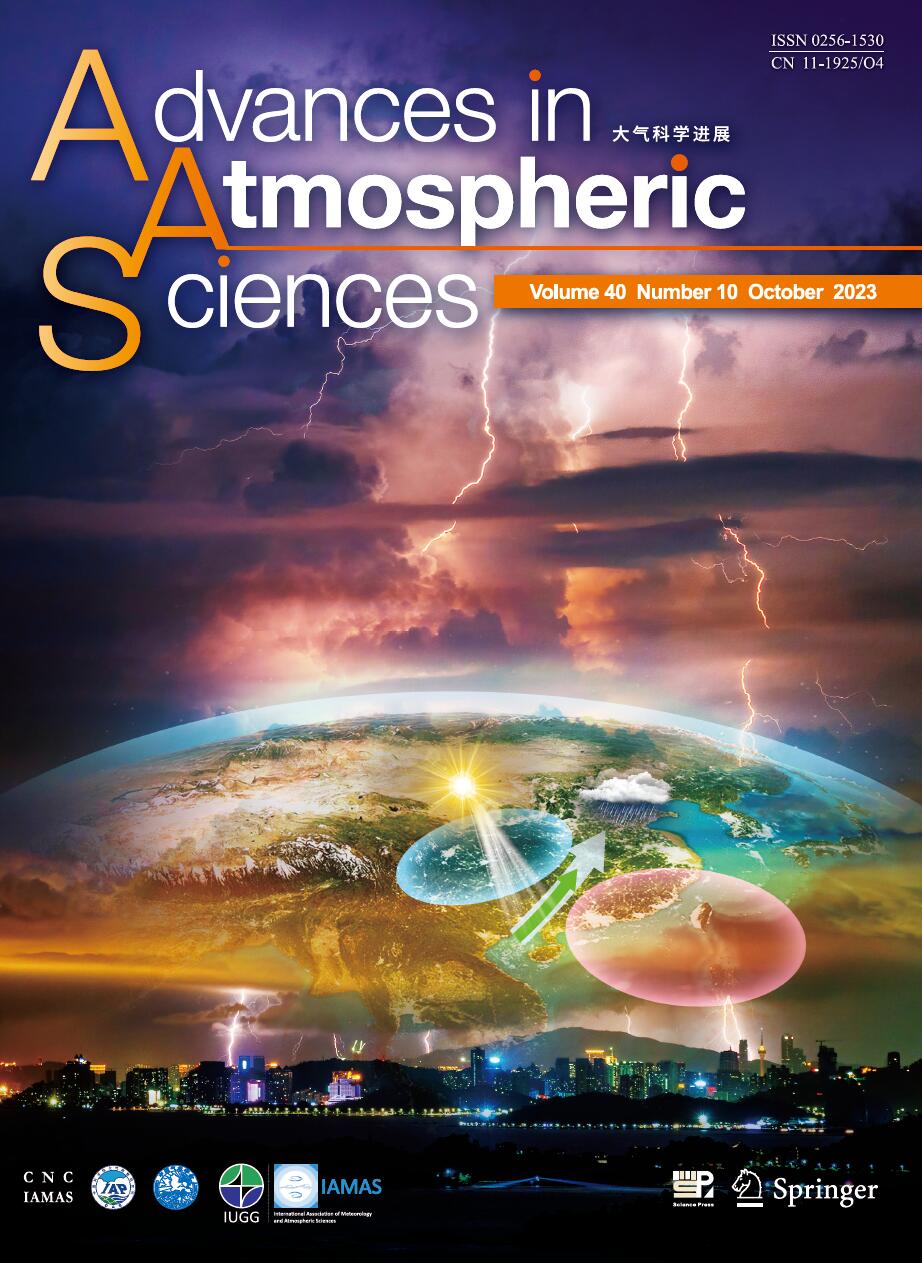| [1] |
Soon-Il An, In-Sik Kang,
2001: Sensitivity of the Equatorial Air-Sea Coupled System to theZonal Phase Difference between SST and Wind Stress, ADVANCES IN ATMOSPHERIC SCIENCES, 18, 155-165.
doi: 10.1007/s00376-001-0010-8
|
| [2] |
Ting ZHANG, Jinbao SONG,
2018: Effects of Sea-Surface Waves and Ocean Spray on Air-Sea Momentum Fluxes, ADVANCES IN ATMOSPHERIC SCIENCES, 35, 469-478.
doi: 10.1007/s00376-017-7101-7
|
| [3] |
Chunlei LIU, Yazhu YANG, Xiaoqing LIAO, Ning CAO, Jimmy LIU, Niansen OU, Richard P. ALLAN, Liang JIN, Ni CHEN, Rong ZHENG,
2022: Discrepancies in Simulated Ocean Net Surface Heat Fluxes over the North Atlantic, ADVANCES IN ATMOSPHERIC SCIENCES, 39, 1941-1955.
doi: 10.1007/s00376-022-1360-7
|
| [4] |
YAN Li, WANG Panxing, YU Yongqiang, LI Lijuan, WANG Bin,
2010: Potential Predictability of Sea Surface Temperature in a Coupled Ocean--Atmosphere GCM, ADVANCES IN ATMOSPHERIC SCIENCES, 27, 921-936.
doi: 10.1007/s00376-009-9062-y
|
| [5] |
LI Weibiao,
2004: Modelling Air-Sea Fluxes during a Western Pacific Typhoon: Role of Sea Spray, ADVANCES IN ATMOSPHERIC SCIENCES, 21, 269-276.
doi: 10.1007/BF02915713
|
| [6] |
Peter CHU, CHEN Yuchun, Akira KUNINAKA,
2005: Seasonal Variability of the Yellow Sea/East China Sea Surface Fluxes and Thermohaline Structure, ADVANCES IN ATMOSPHERIC SCIENCES, 22, 1-20.
doi: 10.1007/BF02930865
|
| [7] |
Fu Congbin, Robert Pyle, Fan Huijun,
1994: A Comparison Study of the Climatological Air-Sea Heat Fluxes Estimated by Different Computational Schemes of Bulk Formula, ADVANCES IN ATMOSPHERIC SCIENCES, 11, 189-200.
doi: 10.1007/BF02666545
|
| [8] |
Fangyuan CHENG, Qinghua YANG, Changwei LIU, Bo HAN, Shijie PENG, Guanghua HAO,
2023: Evaluating Parameterizations for Turbulent Fluxes over the Landfast Sea-Ice Surface in Prydz Bay, Antarctica, ADVANCES IN ATMOSPHERIC SCIENCES, 40, 1816-1832.
doi: 10.1007/s00376-023-2299-z
|
| [9] |
CHEN Feng, XIE Zhenghui,
2011: Effects of Crop Growth and Development on Land Surface Fluxes, ADVANCES IN ATMOSPHERIC SCIENCES, 28, 927-944.
doi: 10.1007/s00376-010-0105-1
|
| [10] |
MA Yaoming, Massimo MENENTI, Reinder FEDDES,
2010: Parameterization of Heat Fluxes at Heterogeneous Surfaces by Integrating Satellite Measurements with Surface Layer and Atmospheric Boundary Layer Observations, ADVANCES IN ATMOSPHERIC SCIENCES, 27, 328-336.
doi: 10.1007/s00376-009-9024-4
|
| [11] |
Yueliang CHEN, Changxiang YAN, Jiang ZHU,
2018: Assimilation of Sea Surface Temperature in a Global Hybrid Coordinate Ocean Model, ADVANCES IN ATMOSPHERIC SCIENCES, 35, 1291-1304.
doi: 10.1007/s00376-018-7284-6
|
| [12] |
Li Chongyin, Liao Qinghai,
1996: Behaviour of Coupled Modes in a Simple Nonlinear Air-Sea Interaction Model, ADVANCES IN ATMOSPHERIC SCIENCES, 13, 183-195.
doi: 10.1007/BF02656861
|
| [13] |
Shao Yongning, Chen Longxun,
1991: On Quasi-Biennial Oscillation in Air-Sea System, ADVANCES IN ATMOSPHERIC SCIENCES, 8, 11-22.
doi: 10.1007/BF02657361
|
| [14] |
Ji Zhengang, Chao Jiping,
1987: TELECONNECTIONS OF THE SEA SURFACE TEMPERATURE IN THE INDIAN OCEAN WTTH SEA SURFACE TEMPERATURE IN THE EASTERN EQUATORIAL PACIFIC, AND WITH THE 500 hPa GEOPOTENTIAL HEIGHT FIELD IN THE NORTHERN HEMISPHERE, ADVANCES IN ATMOSPHERIC SCIENCES, 4, 343-348.
doi: 10.1007/BF02663604
|
| [15] |
LIU Ximing, CHENG Xueling, WU Qiong, FU Minning, ZENG Qingcun,
2013: Some Characteristics of the Surface Boundary Layer of a Strong Cold Air Process over Southern China, ADVANCES IN ATMOSPHERIC SCIENCES, 30, 210-218.
doi: 10.1007/s00376-012-1223-8
|
| [16] |
Xiang LI, Tiejun LING, Yunfei ZHANG, Qian ZHOU,
2018: A 31-year Global Diurnal Sea Surface Temperature Dataset Created by an Ocean Mixed-Layer Model, ADVANCES IN ATMOSPHERIC SCIENCES, 35, 1443-1454.
doi: 10.1007/s00376-018-8016-7
|
| [17] |
FANG Yongjie, ZHANG Yaocun, HUANG Anning, LI Bo,
2013: Seasonal and Intraseasonal Variations of East Asian Summer Monsoon Precipitation Simulated by a Regional Air-Sea Coupled Model, ADVANCES IN ATMOSPHERIC SCIENCES, 30, 315-329.
doi: 10.1007/s00376-012-1241-6
|
| [18] |
Lei YU, Jiping LIU, Yongqi GAO, Qi SHU,
2022: A Sensitivity Study of Arctic Ice-Ocean Heat Exchange to the Three-Equation Boundary Condition Parametrization in CICE6, ADVANCES IN ATMOSPHERIC SCIENCES, 39, 1398-1416.
doi: 10.1007/s00376-022-1316-y
|
| [19] |
Alexey V. ELISEEV, Igor I. MOKHOV, Konstantin G. RUBINSTEIN, Maria S. GUSEVA,
2004: Atmospheric and Coupled Model Intercomparison in Terms of Amplitude-Phase Characteristics of Surface Air Temperature Annual Cycle, ADVANCES IN ATMOSPHERIC SCIENCES, 21, 837-847.
doi: 10.1007/BF02915586
|
| [20] |
Yan Jinghua, Chen Longxun, Wang Gu,
1988: THE PROPAGATION CHARACTERISTICS OF INTERANNUAL LOW-FREQUENCY OSCILLATIONS IN THE TROPICAL AIR-SEA SYSTEM, ADVANCES IN ATMOSPHERIC SCIENCES, 5, 405-420.
doi: 10.1007/BF02656787
|















 AAS Website
AAS Website 
 AAS WeChat
AAS WeChat 
 DownLoad:
DownLoad: